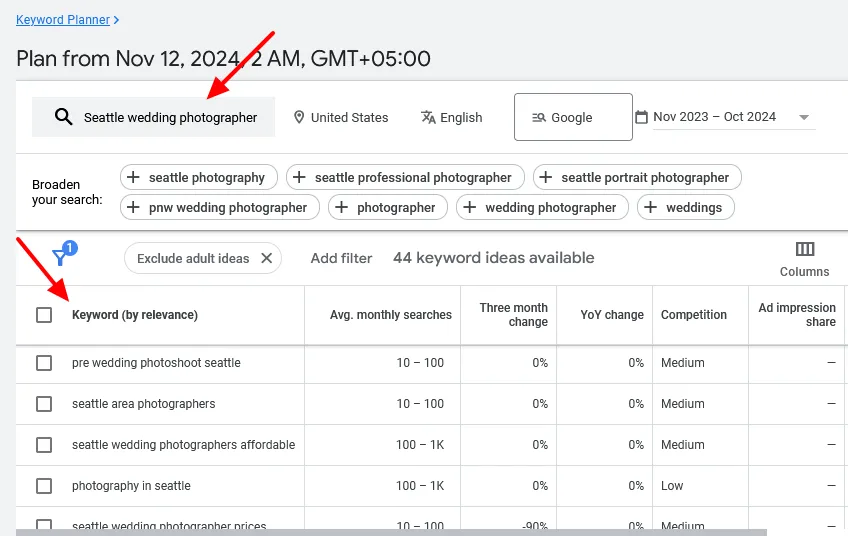Are you a professional photographer and want to boost your visibility and attract more clients? You’re in the right place.
For professional photographers, attracting local clients is essential for building a sustainable business.
While photography is often a visual and portfolio-based profession, visibility in local search results is key to connecting with nearby customers actively looking for services.
Implementing effective Local SEO (Search Engine Optimization) strategies can increase your chances of appearing on search results when potential clients in your area are searching for a photographer.
Following topics will be covered in this post:
- Optimize Your Google Business Profile
- Use Consistent NAP Information Across Platforms
- Focus on Local Keywords
- Build Local Citations and Directory Listings
- Create Geo-Tagged Content
- Utilize Social Media for Local Engagement
- Get Backlinks from Local Websites
- Optimize Website for Mobile
- Regularly Update Your Content
- Track and Measure Your Results
RELATED
- Best Content Marketing Tools for Beginners
- How to Create Content Marketing Calendar: Comprehensive Guide
- Content Marketing Mistakes to Avoid: A Comprehensive Guide
- Why Does it Take So Long to Get Traffic on New Blogs, Even With Good Content, and SEO?
- How to Optimize for “Near Me” Searches for Local Services
- How to Optimize Your Blog for Voice Search
- Understanding Google Lens SEO: Optimizing for Visual Search
- Technical SEO for Bloggers Without Coding Skills
|| Looking for amazing responsive themes starting from $2? Find Here. Looking for a fast-performance web-hosting? Get Here.
01. Optimize Your Google Business Profile
A well-maintained Google Business Profile (GBP) is crucial for local SEO. This profile appears when users search for your business or relevant keywords in Google Search and Maps.
Related: Using Google My Business for Small Businesses: Complete Guide
Below you can see that I have searched for “wedding photographer in new york”. In response to this search query Google Search Results are showing me the list of Business Profiles of photographers in New York with Business Name, Rating, Website, Direction, Phone, Services, Photos, Reviews, Timings, Experience, and Location on Map.

Following are the steps to optimize your Google Business Profile:
- Make sure to claim and verify your Google Business Profile if you haven’t already.
- Fill out every section, including business name, address, phone number (NAP), website link, and hours of operation.
- Use “Photographer”, “Wedding Photographer”, “Event Photographer”, etc., or specific categories relevant to your work.
- Showcase your best work directly on your GBP. High-quality images enhance your profile’s appeal and give potential clients an idea of your style.
- Ask satisfied clients to leave reviews, as positive reviews not only build credibility but also improve your local SEO ranking.
02. Use Consistent NAP Information Across Platforms
Consistency is key in Local SEO. Make sure your Name, Address, and Phone number (NAP) are consistent across your website, social media, and online directories.
- Ensure that the business name, address, and phone number match across platforms like Yelp, Bing Places, and other directory listings.
- Include your NAP information on your website’s contact page, and ideally in the footer of every page.
- Adding Local Business Schema Markup to your website code helps search engines understand your location and other information. This markup provides search engines with structured data that can improve local rankings.
03. Focus on Local Keywords
Choosing the right keywords helps you connect with local clients actively looking for photography services in your area.
- Use tools like Google Keyword Planner, Mangools SEO, or Ubersuggest to identify local keywords, like “Seattle wedding photographer” or “portrait photographer in Miami”.
- Incorporate local keywords into your Page Titles, Headers, and Meta Descriptions. For example, a title might be “Professional Family Photographer in Austin, TX”.
- Write blog posts or portfolio descriptions that naturally include local terms. For instance, you might have a blog post titled “Best Outdoor Photoshoot Locations in San Francisco”.

04. Build Local Citations and Directory Listings
Citations are online mentions of your business, and they help search engines verify your business’s existence and relevance in local searches.
- Add your business to directories like Yelp, Bing Places, and Yellow Pages. Also, consider niche photography directories or local chambers of commerce.
- Ensure that your information is consistent and accurate across these listings. Even minor discrepancies can impact your SEO negatively.
- Consider listings on platforms like The Knot, WeddingWire, or other photography portfolio websites, which often have high domain authority.
05. Create Geo-Tagged Content
Geo-tagging adds location information to your photos, videos, and blog posts, making it easier for search engines to associate your content with a specific area.
- Use tools like GeoImgr to add location data to your photos. Uploading geotagged images on your website can improve your local SEO.
- Highlight recent work you’ve done in specific areas. For example, a blog post on a “Wedding Photography Session in Brooklyn Bridge Park” can help you rank for searches related to that location.
- If you have a studio or a regular work location, embed a Google Map with your address on your website’s contact page. This boosts the location signal for local SEO.
06. Utilize Social Media for Local Engagement
Active social media profiles help improve local SEO by increasing brand recognition and online presence.
- Use city-specific hashtags (e.g., #ChicagoPhotography) on platforms like Instagram and Twitter to engage with a local audience.
- Share images from recent local photoshoots and tag the location, both in the image and in the caption.
- Collaborate with other local businesses, such as wedding planners, event spaces, influencers, or stylists. Cross-promotions can increase your visibility among new audiences.

RELATED
- Analytics Advantage: Driving Social Media Success with Data Insights
- Mastering the Art of Targeted Advertising on Social Media Platforms
- A Comprehensive Guide for Building a Successful Instagram Profile
- A Complete Guide to Understanding Instagram Insights | Analytics Evolution
- How to Optimize Images For Pinterest SEO
07. Get Backlinks from Local Websites
Backlinks are links from other websites to your website and pages, are an essential part of SEO. For local SEO, prioritize backlinks from local sources.
- Reach out to local lifestyle bloggers or influencers and ask if they’d be interested in featuring your photography services.
- Sponsor a community event or collaborate with local businesses. For example, you could photograph a local charity event, which might lead to backlinks from their website.
- Write guest posts for local magazines, blogs, or news sites about topics related to photography in your area, such as “Tips for the Perfect Fall Photoshoot in New York City”.
RELATED
- How to Ensure Backlinks are Placed on High Quality Sites?
- How to Know If Backlinks are Helping or Hurting Your Website?
08. Optimize Website for Mobile
Many potential clients use their phones to search for local photographers, so you must optimize your website for mobile devices.
- Use a responsive design that adjusts to fit mobile screens seamlessly.
- Google uses page load speed as a ranking factor, and mobile users expect quick load times. Optimize image sizes, reduce scripts, and consider a Content Delivery Network (CDN) for faster loading.
- Make it easy for potential clients to reach you with a simple click-to-call button on your website.

09. Regularly Update Your Content
Updating your content signals to Google that your website is active and relevant, which helps with search rankings.
- Regular blogging about local events, recent photoshoots, or tips for clients helps keep your website fresh.
- If you have seasonal promotions (e.g., holiday mini sessions), create dedicated landing pages for them to capture local searches related to these events.
- Regularly update your portfolio with recent work, and optimize the descriptions for local keywords.
10. Track and Measure Your Results
Once you’ve implemented these strategies, track the impact of your Local SEO efforts to see what works best.
- Use Google Analytics to track website traffic, particularly from local sources. Analyze which pages are most popular and identify local search terms that lead people to your site. Related: How To Sign Up & Link Website With Google Analytics 4 (GA4)
- Monitor your Google Business Insights as Google provides insights on how people find your business, where they are searching from, and what actions they take (like visiting your website or calling).
- If a specific type of content or keyword performs well, focus more on that area to continue optimizing your strategy.

Final Thoughts
Local SEO is essential for photographers looking to grow their business within their community. By optimizing your Google Business Profile, using local keywords, engaging with social media, and connecting with local resources, you can boost your visibility in local search results and attract more clients.
With a consistent and focused approach, Local SEO can drive more traffic, inquiries, and ultimately, bookings. Start implementing these tips today, and watch your local reach expand.
If you like this post then don’t forget to share with other people. Share your feedback in the comments section below.
Also Read






Leave a Reply